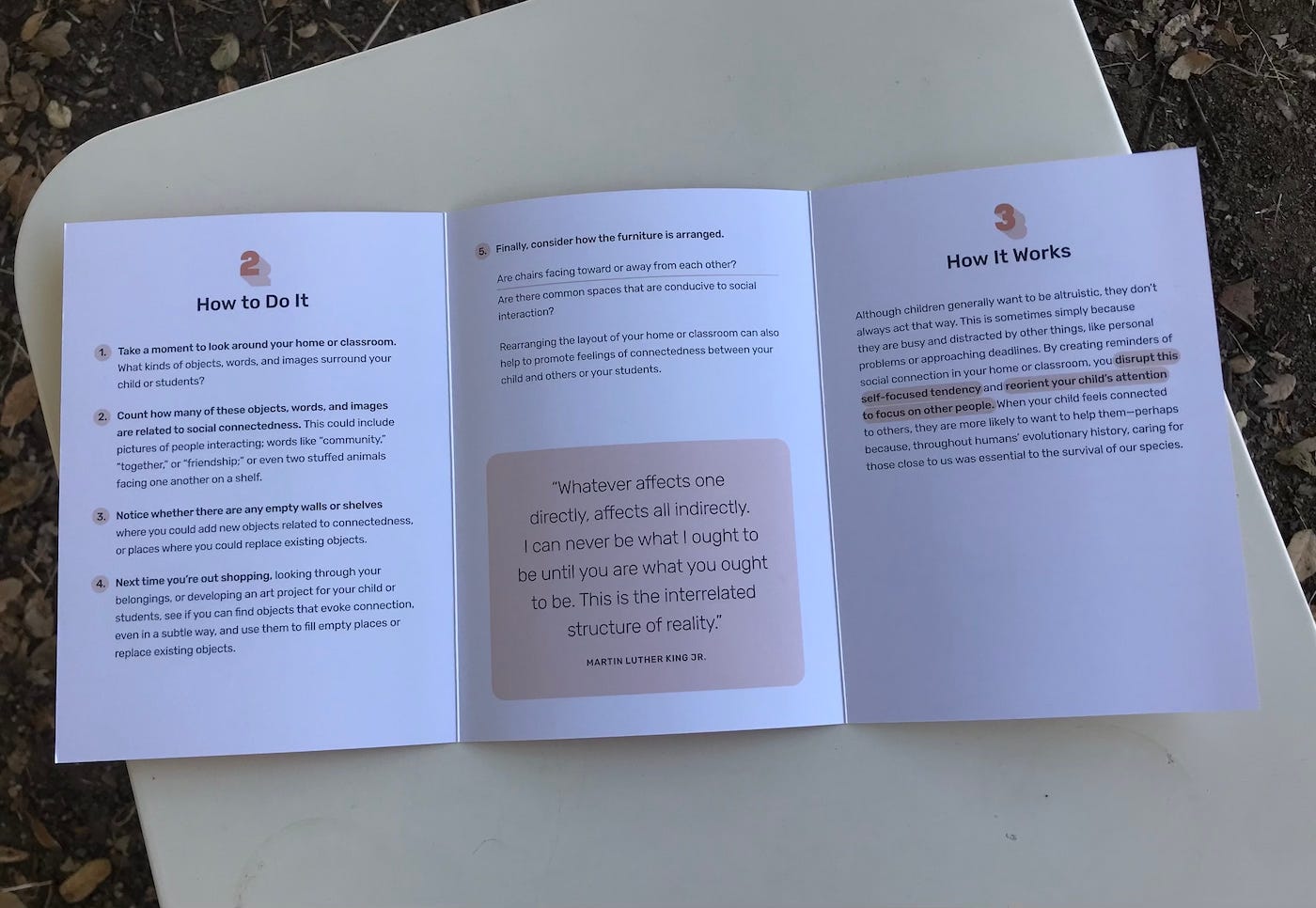Subtle Reminders of Connectedness
Applying the neuroscience of compassion, kindness, and awe
Well-being. It's one of the four keywords that I selected to encapsulate the focus for The Interconnect.
I first became aware of the work of the Greater Good Science Center in 2011. Beginning in January, 2012, I did an 8-week Compassion Cultivation Training at GGSC—the program was designed by The Center for Compassion and Altruism Research and Education (CCARE) based at Stanford University. It was my introduction to the science of compassion.
And back in the early days of MOOCs (remember those?), I enrolled in a “massive open online course” on the Science of Happiness with GGSC’s Founding Director Dacher Keltner and GGSC’s Science Director Emiliana Simon-Thomas. It’s still offered through EdX today, it’s free, and the newest cohort just started 9/8.
These days, I subscribe to the Greater Good Science Center newsletter to keep up with their research and work in the world. In a recent newsletter, I noticed they had a new kit called the Greater Good Toolkit for Kids with the tagline “science-based practices to nurture well-being in young minds.” I ordered it and it arrived a few weeks ago. I've been slowly going through it.
The kit has 28 rainbow color-coded cards with a different practice on each, organized by age group (all ages, preschoolers, middle childhood, and teens), and complexity—from casual, to moderate, to intensive. Each card opens to 3 sections that walk you through Why You Should Try It, How to Do It, How it Works, and the research informing the practice.
The third card in the series offers the practice Reminders of Connectedness (age group: all ages; complexity: moderate). Why You Should Try It points out that “kindness improves the health and happiness of the giver” and then suggests a way to elicit the deeply rooted propensities for kindness in ourselves and children:
...evoke a sense of connectedness among people. Even subtle reminders of connection, ones operating below the conscious level, can lead to concrete, measurable increases in altruistic behavior.
The card then walks you through five steps to help reorient your home, classroom, or office to promote feelings of connectedness.
I was especially struck by the first of the two research examples given on the back of the card.
Here's the summary:
Eighteen-month-old children saw a series of photos that had different household objects in the foreground; for some of these children, in the background were two small dolls facing each other— a subtle reminder of connection. But for other children, in the background were two stacks of blocks, a single doll standing alone, or two dolls turned away from each other. After viewing the photos, all of the children had the opportunity to help an adult in need. The children who had seen the subtle reminder of connection were three times more likely to help the adult.
Practice 3 has me considering small changes I can make to my environment to nurture more social connectedness.
Here are some additional resources to explore on the role of compassion, kindness, and awe in well-being and prosocial behavior.
VIDEOS with Dacher Keltner and GGSC
Train Your Brain to Be Kinder (1:46 mins) — Kids show you how.
We are built to be kind (4:36 mins) — A short animated video on the science of kindness. Human nature is often portrayed as selfish and power hungry, but research by Dacher Keltner finds that we are hard-wired to be kind. Keywords: periaqueductal gray, vagus nerve response, compassion deficit
Survival of the Kindest (53:56 mins) — Dive deep into the neuroscience of kindness and compassion with Dacher Keltner. Topics: sympathy breakthroughs, networks of good will, evolution of compassion, the human voice, nature, the signal of kindness, the tactile modality, compassion and touch, the vagus nerve, and a lot more.
ONLINE COURSE
Awe in Education: Creating Learning Environments that Inspire, Motivate, and Heal — I’m participating. Let me know if you register. (Note: This online course has a tiered registration fee.)
BOOK
A Fearless Heart: How the Courage to Be Compassionate Can Transform Our Lives —Author Thupten Jinpa was instrumental in developing the CCARE Compassion Cultivation Training.
THE TOOLKIT
Thanks for reading. Be well.


